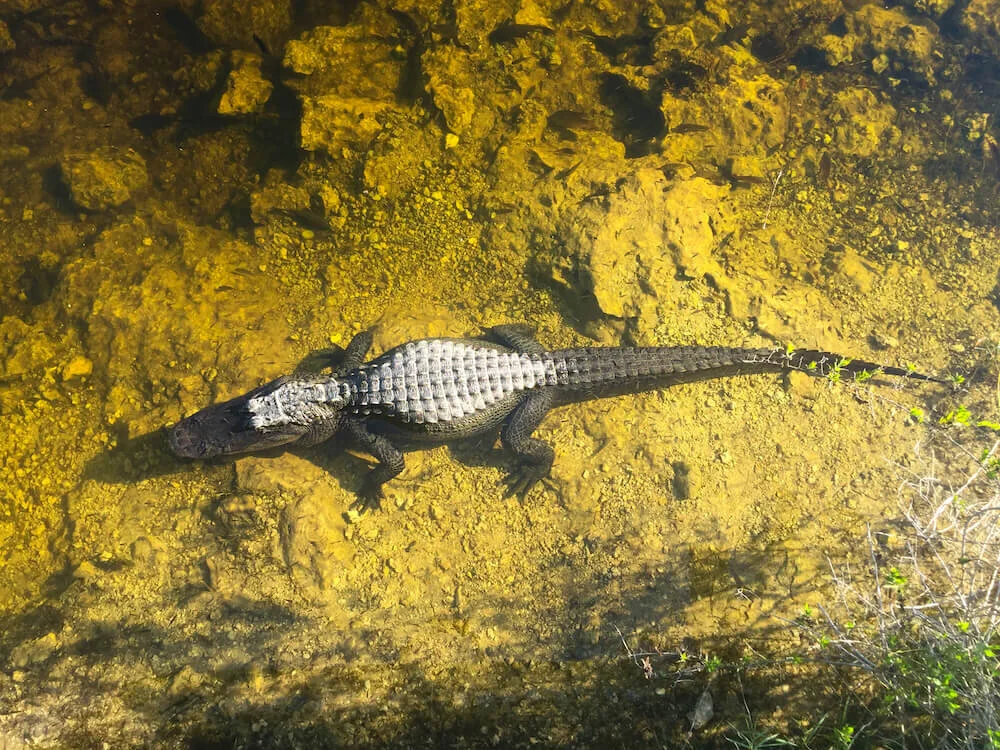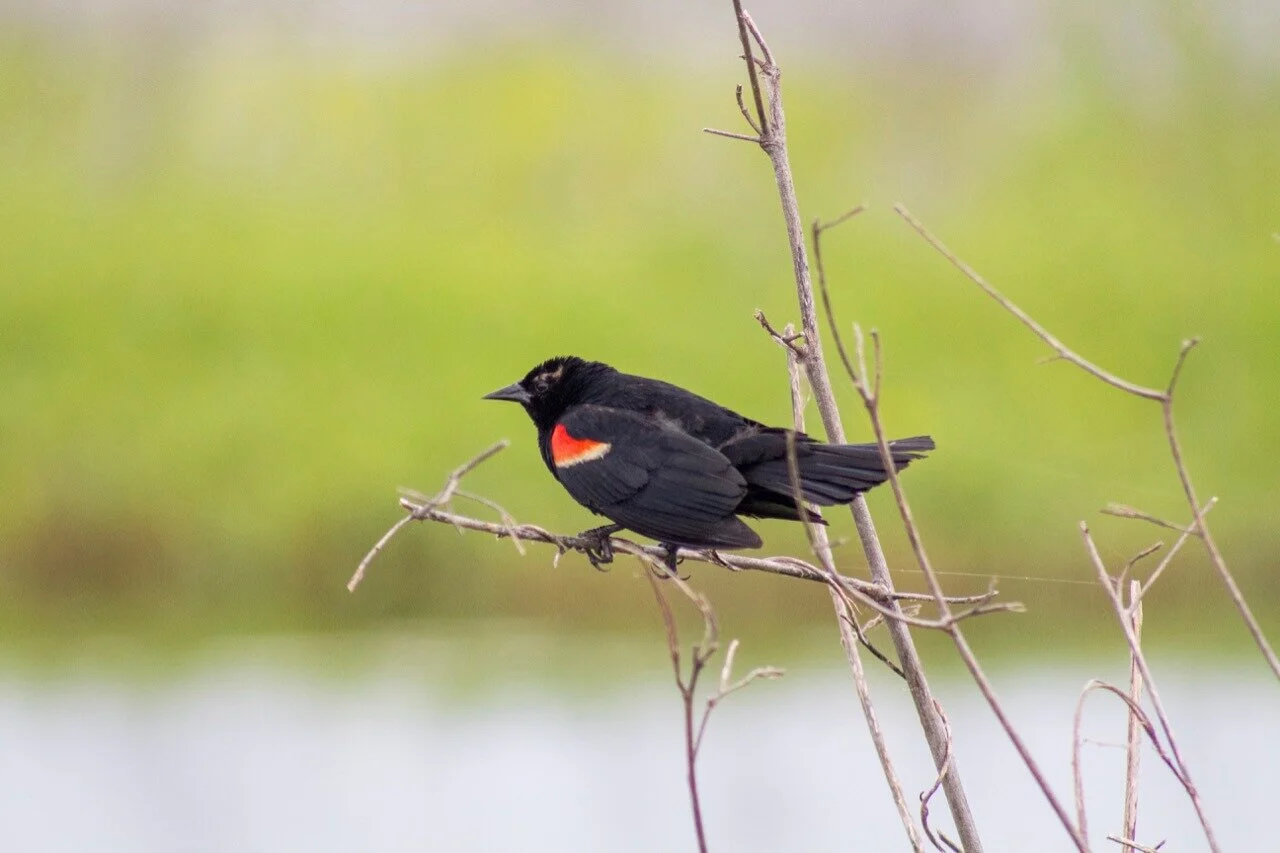Eye to Eye With Alligators at Loxahatchee National Wildlife Refuge
By Laura Power
My husband Dick and I visited Loxahatchee National Wildlife Refuge, in Palm Beach County, on an eighty-degree Florida day. Shortly after we arrived, Dick pointed to a patchwork of wetlands on the refuge map. “Let’s ride here,” he said. “The ranger says it attracts migrating and nesting birds.” The “patchwork” is a collection of rectangular, multi-acre wetlands bounded by bike-able levee-like ridges. Four of the rectangles make up what is called the Loxahatchee Impoundment Landscape Assessment, or LILA, an eighty-acre ecosystem simulation project designed to ultimately restore the Everglades to the mighty but shallow river that once covered a third of Florida—twentieth century development has drained much the Everglades .
Anhinga, photo by Derek Wright.
More than fifty types of birds nest in the refuge, and another two hundred species dwell there permanently, or stop off during migration. I bought a laminated guide, Birds of Southeast Florida, in the gift shop, and we set out, weaving in and out of the wetlands, slowly, slowly riding our bikes on the hard-panned, grassy ridges. In a distant section of the wetland patchwork, a spot of pink caught my eye. I knew the Roseate Spoonbill because of several previous fruitless attempts to find one. We stood quietly for twenty minutes or so, watching it forage in the shallows. Now and then, it paused from swinging its “spoon” in the mudflats to stretch out its wide rosy wings. Ducks floated by. In two hours of leisurely biking, we identified twenty species of birds, including the ubiquitous American White Ibis, characterized by long orange legs and hooked beaks, and the purplish Glossy Ibis and the brown striped American Bittern. The bright red beaks of the Common Gallinule popped against the dark waters of the wetlands. Semipalmated plovers, with their brown backs and white ringed necks, and Red-winged Blackbirds flitted everywhere, along with multiple varieties of egrets and herons; Black Vultures gathered on nearby trees. More than one Snail Kite, an endangered raptor in the hawk family, skimmed low over the wetlands. Anhingas perched on branches, wings spread to dry and soak in the heat.
Great Blue Heron, photo courtesy Laura Power.
Later, we biked a five-mile loop through the Cypress Swamp, and passed a boat launch. There was a little wooden hut, and racks loaded with canoes and kayaks. Out in the adjacent slough, a signpost in the water read “Canoe Trail.” The promise of a closer look at the many species of birds enticed me. Maybe we’d get lucky, and spot another Roseate Spoonbill or a red-headed Pileated Woodpecker or a blue-crested Belted Kingfisher.
But then, dark thoughts of alligators crept in.
*
The American Alligator is omnipresent in Florida, and many live in the Loxahatchee National Wildlife Refuge. The alligator is fierce, a predator whose roots go back perhaps two hundred million years. Its ancestors outlasted multiple climate extremes and vicious carnivores, like dinosaurs and pterosaurs. The modern alligator’s lizard-like body can grow to around eight to fourteen feet and up to a thousand pounds. Its back is covered with small bony patches threaded together with a network of collagen fibers that make its hide strong, flexible, and crack-resistant. It’s got a large and powerful jaw with eighty or so teeth, and unlike most animals, it continuously regenerates lost teeth over its lifetime—so, you will never meet a toothless alligator.
We’d biked the fifteen mile Shark Valley loop in Everglades National Park several times, passing within ten or twenty feet of dozens of sunning and swimming alligators. But the speed of our bikes and the throngs of visitors nearby made it somehow seem safe. At Loxahatchee, I had visions of a gator seizing me out of a canoe and drowning me in a death roll.
American alligator, photo by Amy Beth Wright.
A University of Florida scientist once measured the force of an alligator’s bite at more than 2,100 pounds per square inch. Escaping those jaws would be like “trying to lift a pickup truck off of yourself,” the scientist told ScienceDaily. I imagined myself with my arms wrapped around an alligator’s jaw, squeezing it tight while resisting the powerful thrashing of its tail until park rangers on an airboat swooped in to save me.
I searched online, “What to do in a confrontation with an alligator.” Avoid close contact. Stay thirty feet away. The real danger zone is half a body length, as that’s the distance over which a gator can very rapidly strike.
I reasoned that the Loxahatchee rangers wouldn’t allow canoeing among the alligators if it weren’t reasonably safe. I told myself that if I didn’t go, I would obsess over missing out on spectacular bird watching because of what was, maybe, an irrational fear.
The idea of being eye level with the birds, even though it also meant being bite level with the gators, eventually won out.
*
The five and a half mile canoe trail itself is beautiful. A ten or twelve foot lane cuts in a loop through wet prairie, sawgrass ridge, and tree island habitats. White water lilies, open to show their delicate lemon-hued centers, dotted the sloughs. Still budding yellow spatterduck poked up among verdant heart-shaped pads. Overhead, a bright azure sky, practically cloudless, stretched out, uninterrupted. On a hot and humid day, it was pleasantly cool and even a bit breezy down in the sawgrass. We heard the occasional distant whine of a boat motor, but the noise of the urban sprawl just a few miles away didn’t disturb us.
The paddling, however, was a problem. The canoe we rented was about twelve inches deep, a thickness I thought was well within the capacity of an average alligator jaw. We paid a little extra for plastic seat-backs that clipped onto the canoe’s built-in benches, which helped with stability, but still, the canoe felt flimsy, and easily tipped.
On the canoe trail, photo courtesy Laura Power.
Dick insisted on manning the rear, leaving me in the front seat. He paddled toward the slough’s edges, which I thought of as prime alligator hiding places; I repeatedly cried out, “We have to stay in the middle!” as I paddled furiously in an opposite direction.
The slough seemed surprisingly shallow. In most places, my eye judged the water to be a foot and a half deep, maybe two. At first, that felt comforting. I reasoned that if an alligator attacked, at least I could stand up to get some leverage to fight back. But when I pressed my oar down through the water, I couldn’t feel a hard bottom. “It looks shallow,” I warned Dick, “but the bed is soft and mucky. It’s just mire or maybe quicksand.”
About a half mile into the trail, Dick spotted a gator. “To your left,” he whispered. And there, lurking just above the water line, was a pair of alligator eyes, still, quiet, and intent. I was too scared to scramble for the point and shoot camera at the bottom of the canoe. We paddled away briskly.
Several hundred yards further, a second gator (too close, I thought) silently observed us glide by. Then, short of the trail’s one mile marker, I saw a third gator twenty or so yards distance, on the move. I yelled to Dick, ”Keep left! Keep left!” I paddled hard to veer out of the gator’s path. As we neared, it suddenly and quietly disappeared beneath the water, leaving behind dozens of tiny bubbles. I focused on the slough ahead, looking for the telltale jawline and back-hump. From a distance, bits of mud-caked roots jutting up out of the water looked remarkably like alligators.
We went on for another mile or so with no new sightings. Then, too late to change course, I noticed a crop of surface bubbles directly ahead, and, as we passed through them, the dark shadow of a gator below. “We just went right over one!” I cried.
I could not relax. My job, I told myself, is to paddle, as strongly and consistently as I can, and to keep my eyes moving, looking for trouble. We oared steadily through the slough, pausing only briefly to read the interpretive signs placed at intervals along the trail. We saw birds, yes, but I cannot name one of them. Finally, after a couple of hours and several more alligator sightings, we passed the trail’s five mile marker. I pulled hard for another two hundred yards, before easing up on my oar. “The landing must be just around this curve,” I told Dick.
Red-winged blackbird, photo by Derek Wright.
A Red-Winged Blackbird flitted in a nearby scrubby tree, and I lifted my oar to let the boat drift as I paused to look. I’d seen many of them on our first day at the refuge, but I didn’t have any photos. I turned to grab my camera.
On the opposite side of the canoe, so close I could reach out and pat it on the head, was an alligator, at least five or six feet long. Before I could dip my oar into the water to get away, the gator lunged toward the boat and, with a splash, dove beneath it.
My heart stopped. The alligator vanished, but I couldn’t stifle a shriek. Dick exercised his oar so that in a minute or two the landing indeed appeared, just ahead. “Now I can breathe,” I said.
Back on dry land, Dick confessed that he hadn’t pointed out all of the alligators he’d seen. He had not mentioned an especially large gator, maybe ten feet long, that shimmied off of a bank and swam directly at us. “It was just after we launched,” he said. I didn’t need to know that.
A view of Loxahatchee NWR from the canoe trail, photo courtesy Laura Power.
I’d wanted to observe birds, but in my preoccupation with the great lizards, I didn’t much notice the herons and egrets and ibis in the sawgrass, the songbirds in the trees, or the raptors overhead. But I did leave feeling strangely sympathetic to the alligator that I so feared. Surely, this wild and ugly creature, at the top of its food chain, must play an essential role in the balance of nature?
I bought Kelby Ouchley’s book, American Alligator: Ancient Predator in the Modern World. He calls the alligator a keystone species, one that has a critical influence on its ecosystem. The holes that gators dig out in the wetlands supply protection for fish, birds, and other animals, particularly during dry spells. Turtle and snake eggs have been found co-habitating in the relative safety of alligator nests. And, writes Ouchley, alligators help keep populations of their own prey and down-chain species at healthy numbers. Its vision is sharp, its sense of smell, intense—it can even see underwater because of transparent eye covers that slide closed when it submerges. Little bumps around the alligator’s mouth are so sensitive, detecting the disturbance of a single drop of water falling into in a large pool. At night, the alligator can somehow align its body with the stars.
I more so appreciated paddling among the gators, and I undeniably loved the Loxahatchee National Wildlife Refuge. On my next visit, however, I plan to seek out a ranger-led bird walk or photography tour—I’ll leave the canoeing to the brave.
Laura Power is a some-time freelance writer and a former business consultant. In the last decade, she and her husband have criss-crossed the continental United States six times, at first with tenting gear and more recently with a travel trailer. They've visited 40 National Parks and Monuments. At home, Laura enjoys all the outdoor recreations that her adopted home state of Vermont offers.

















